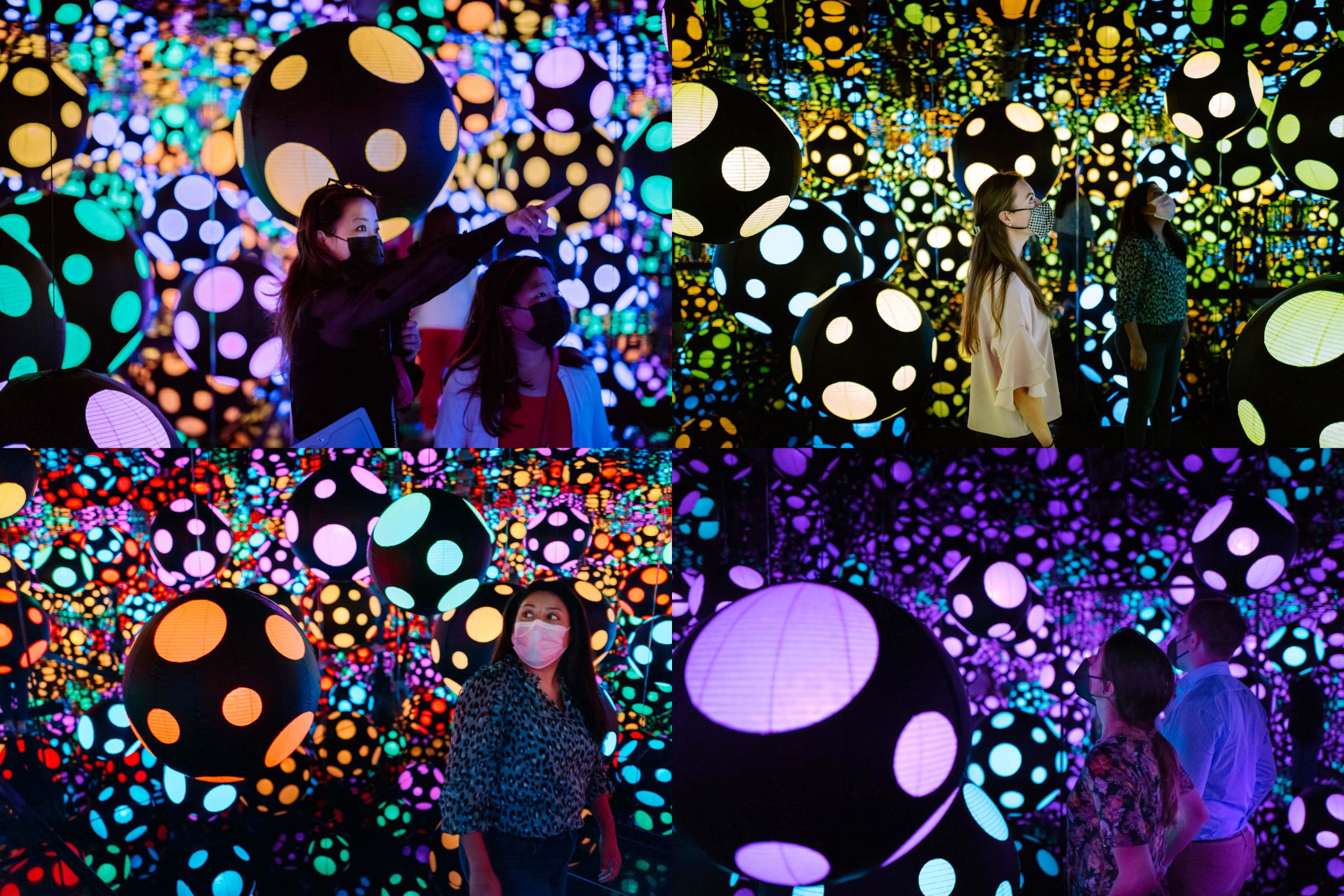Hirshhorn Announces April 1 Opening Date for “One with Eternity: Yayoi Kusama in the Hirshhorn Collection”

March 7, 2022
Hirshhorn Announces April 1 Opening Date for “One with Eternity: Yayoi Kusama in the Hirshhorn Collection
Exhibition Builds on Record-Breaking 2017 Exhibition and North American Tour Initiated by the Hirshhorn, April 1–Nov. 27
The Hirshhorn Museum and Sculpture Garden will debut “One with Eternity: Yayoi Kusama in the Hirshhorn Collection,” a focused look at the celebrated artist’s nearly seven-decade long career, April 1–Nov. 27. Presented nearly five years after the Hirshhorn’s milestone exhibition “Yayoi Kusama: Infinity Mirrors,” this exhibition will showcase work by Kusama from the museum’s permanent collection, featuring two recently acquired Infinity Mirror Rooms.
The exhibition sits alongside the museums programs that highlight the work of women artists, which includes a major survey of Laurie Anderson, a thematic 40-painting exhibition by Toyin Ojih Odutola and an upcoming first-time exhibition of women and non-binary artists in the museum’s collection including Barbara Hepworth, Deborah Roberts and Alma Thomas.
“This highly anticipated exhibition allows us to show the impact of Kusama’s radical practice and welcome three significant works into the permanent collection,” said Hirshhorn Director Melissa Chiu. “‘One with Eternity: Yayoi Kusama in the Hirshhorn Collection’ demonstrates that Kusama’s legacy extends far beyond a single body of work.
The Hirshhorn will issue free, same-day timed passes to “One with Eternity: Yayoi Kusama in the Hirshhorn Collection” on a first-come, first-served basis beginning at 9:30 a.m. daily outside on the museum’s plaza. Timed passes are required for this exhibition, but not for entry into the Hirshhorn Museum, other exhibitions and public spaces. As one of their member benefits, Hirshhorn Insiders are invited to either preview the exhibition or plan ahead by booking timed passes online. The museum has partnered with Etix to manage online pass distribution for members. For more information about timed passes, visit the exhibition’s FAQ.
Organized by Betsy Johnson, assistant curator at the Hirshhorn, “One with Eternity: Yayoi Kusama in the Hirshhorn Collection” charts Kusama’s unique studio practice in the context of the museum’s collection holdings. Among the acquisitions on view will be two of Kusama’s otherworldly Infinity Mirror Rooms, which together represent the continuing trajectory of the artist’s bold investigation of space and time through illusions of infinity.
“Infinity Mirror Room—Phalli’s Field (Floor Show)” (1965/2017) is the 2017 reimagining of Kusama’s breakthrough installation that first debuted in 1965, and “Infinity Mirrored Room—My Heart Is Dancing into the Universe” (2018), acquired jointly with the Albright-Knox Art Gallery in Buffalo, New York, is one of the artist’s more recent rooms. As part of the exhibition, additional sculptures, an early work on paper and photographs of the artist will also be on view, giving visitors a comprehensive look into how the artist has continued to innovate and explore new avenues of artmaking. These include an early painting titled “The Hill, 1953 A (No. 30)” (1953), “Flowers—Overcoat” (1964) and an immersive presentation of “Pumpkin” (2016) in which viewers are surrounded by walls wrapped in the artist’s signature polka-dots. The Hirshhorn has collected the artist’s work since 1996.
In 2017, the Hirshhorn welcomed a record 475,000 visitors during the exhibition—its highest spring visitation since the museum’s opening in 1974, doubling its attendance that year to 1.2 million. The touring exhibition welcomed more than 800,000 visitors to partner museums across the U.S. and Canada during the next two years. The impact of “Yayoi Kusama: Infinity Mirrors” across social media reached an unprecedented global audience with the exhibition hashtag #InfiniteKusama extending to more than 172 million Twitter and Instagram accounts and generating more than 716 million impressions. This digital footprint catalyzed audiences around the world to engage with Kusama’s work on a new scale and demonstrated the transformational power of sharing interactions with Kusama’s work on social media. As audiences continue to share their experiences digitally, “One With Eternity” gives visitors another opportunity to connect with friends and followers across the globe.
The exhibition will be activated through the museum’s award-winning smartphone art guide, Hirshhorn Eye (Hi). Visitors can scan exhibition artworks using Hi’s image-recognition software to unlock artist insights into the Hirshhorn’s collection and Kusama’s prolific career.
One with Eternity: Yayoi Kusama in the Hirshhorn Collection is organized by the Hirshhorn Museum and Sculpture Garden and has been made possible with generous support from La Grande Dame by Veuve Clicquot
About the Artist
Kusama (b. 1929, Matsumoto, Nagano, Japan) continues to produce paintings at her studio in Tokyo. She studied traditional Nihonga (Japanese-style) painting in Kyoto before moving to New York City in 1958. There she was active in avant-garde circles during the formative years of Pop art and Minimalism, exhibiting her work alongside such artists as Andy Warhol and Claes Oldenburg—both of whom cited Kusama as influential to the development of Assemblage art, environmental art and performative practices. Kusama exhibited widely in Italy, Germany and the Netherlands in the mid-1960s, participating in exhibitions with artists associated with the Nul, Zero and New Tendency movements in Europe and beginning to develop her interest in optics and interactive elements such as mirrors, electric lights, sound and kinetics. Kusama’s fame grew in the late ’60s through her radical antiwar “Happenings,” which featured nudity and polka dots in the streets of New York. Kusama returned to Japan in 1973, where she has since resided. In recent years, Kusama has achieved celebrity status and tremendous critical respect.
About the Hirshhorn
The Hirshhorn Museum and Sculpture Garden is the national museum of modern and contemporary art and a leading voice for 21st-century art and culture. Part of the Smithsonian, the Hirshhorn is located prominently on the National Mall in Washington, D.C. Its holdings encompass one of the most important collections of postwar American and European art in the world. The Hirshhorn presents diverse exhibitions and offers an array of public programs on the art of our time—free to all. The Hirshhorn Museum is open Thursday to Sunday 10 a.m.–5:30 p.m.. The Hirshhorn Museum’s outdoor sculpture garden is open daily 10 a.m.–5:30 p.m. For more information, visit hirshhorn.si.edu. Follow the museum on Facebook, Instagram, Twitter and YouTube.
Image: Visitors experiencing Yayoi Kusama’s “Infinity Mirrored Room—My Heart Is Dancing into the Universe” (2018) at the Hirshhorn Museum and Sculpture Garden. Photo by Matailong Du. Wood and glass mirrored room with paper lanterns, 119 5/8 x 245 1/8 x 245 1/8 in. (304 x 622.4 x 622.4 cm). Courtesy Ota Fine Arts and Victoria Miro, London/Venice. © YAYOI KUSAMA. Purchased jointly by the Hirshhorn Museum and Sculpture Garden, Smithsonian Institution, Washington, D.C. (Joseph H. Hirshhorn Purchase Fund, 2020), and the Albright-Knox Art Gallery, Buffalo, with funds from the George B. and Jenny R. Mathews Fund, by exchange.
